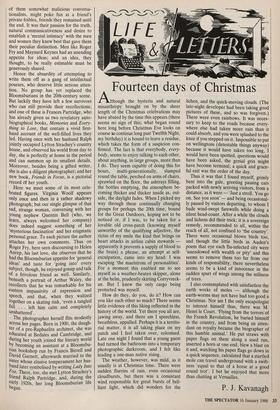A room with a viewfinder
Peter Quennell
FRIENDS IN FOCUS: A LIFE IN PHOTOGRAPHS by Frances Partridge Chau° &Windus, £12.95 Weekly book reviews are sometimes all the livelier if they reflect a violent personal prejudice. Not long ago, for example, a reviewer reminded us that the works of Rudyard Kipling had just come out of copyright, and were thus emerging, he added, from a period of comparative neglect that the great story teller had once suffered 'as a result of "Bloomsburifica- tion", the hijacking of this country's liter- ary values in the 1920's by a gang of posturing, upper-class fops!'
Seldom have so many misleading state- ments been crammed into a single para- graph. The chief Bloomsburians were not, and did not pretend to be, scions of the British upper class; they were descended from a native haute bourgeoisie that in- cluded the Trevelyans, the Wedgewoods, the Birrells and, of course, the Stracheys themselves, which had helped to govern late-Victorian England. Nor were they ever fops. They dressed oddly but unself- consciously. There was nothing foppish about Lytton Strachey's hat and beard, or Clive Bell's shirts and decorative ties. Virginia Woolf s and Vanessa Bell's flow- ing pre-Raphaelite robes bore no rela- tionship to current fashions. Literary mod- es they may occasionally have influenced; but to suggest that they 'hijacked' public taste, is gratuitiously absurd.
They were not a coterie but an assemb- lage of friends, who had first met and talked at Cambridge, and in London still found one another's companionship highly stimulating and enjoyable. If they had had an early guide, it was the philosopher George Edward Moore, whose Principia Ethica appeared in 1903. 'By far the most valuable things . . . we know or can imagine', Moore assured them, 'are certain states of consciousness, which may be roughly described as the pleasures of hu- man intercourse and the enjoyment of beautiful objects.' Those states, he con- cluded, were 'the raison d'être of virtue'.
Not only did Moore encourage the young Bloomsburians' love of cult; but he glorified their art of friendship. Although they frequently disagreed, and, being most of them somewhat malicious conversa- tionalists, might poke fun at a friend's private foibles, friends they remained until the end. It was their passion for the truth, natural communicativeness and desire to establish a 'mental intimacy' with the men and women they knew best that gave them their peculiar distinction. Men like Roger Fry and Maynard Keynes had an unending appetite for ideas; and an idea, they thought, to be really estimable must be generously shared.
Hence the absurdity of attempting to write them off as a gang of intellectual poseurs, who deserve little serious atten- tion. No group has yet replaced the Bloomsburians in the 20th-century scene.
But luckily they have left a few survivors who can still provide their recollections; and one of these is Frances Partridge, who has already given us two revelatory auto- biographical books, Memories and Every- thing to Lose, that contain a vivid first- hand account of the well-filled lives they led. Having once with her husband Ralph jointly occupied Lytton Strachey's country house, and observed his world from day to day, she is perfectly at home in the period and can summon up its smallest details.
Moreover, besides being a gifted writer, she is also a diligent photographer; and her new book, Friends in Focus, is a pictorial record of her youth. Here we meet some of its most cele- brated figures. Virginia Woolf appears only once and then in a rather shadowy photograph; but our single glimpse of that sad, strange woman, conversing with her young nephew Quentin Bell (who, we learn, always welcomed her company) does indeed suggest something of her 'mysterious fascination' and her enigmatic Personal grace. To each picture the author attaches her own comments. Thus on Roger Fry, here seen discoursing to Helen Anrep, his last love, she observes that he had the Bloomsburian appetite for 'general ideas' and taste for 'going into' every subject, though, he enjoyed gossip and talk of a frivolous friend as well. Similarly, beneath a portrait of Arthur Waley, she recollects that he was remarkable for his eastern impassivity of expression and Speech, and that, when they waltzed together on a skating rink, 'even a tangled fall . . . left him calm and completely unshattered'.
The photographer herself flits modestly across her pages. Born in 1900, the daugh- ter of a pre-Raphaelite architect, she was educated at Bedales and Cambridge, and during her youth joined the literary world by becoming an assistant at a Bloomsbu- rian bookshop run by Francis Birrell and David Garnett, afterwards married to the sister whose elusive temperament her hus- band later symbolised by writing Lady Into Fox. There, too, she met Lytton Strachey 's friend Ralph Partridge, and, during the early 1920s, her long Bloomsburian life began.



















































 Previous page
Previous page